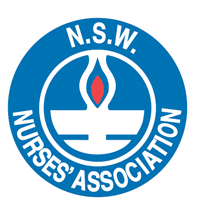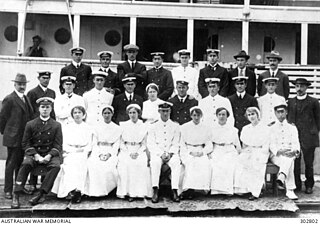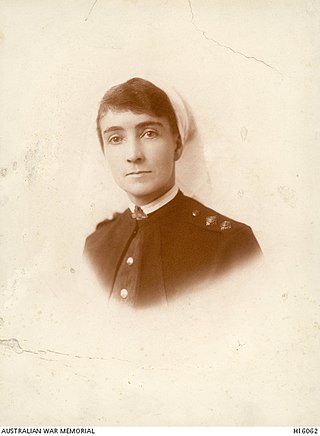
The Australian Nursing and Midwifery Federation (ANMF) is the largest union in Australia, with 274,956 members in 2018. The union is run by nurses, midwives and assistants in nursing to advance the industrial, political and professional interests of its members.

The New South Wales Nurses and Midwives' Association (NSWNMA) is a trade union which represents nurses and midwives in both the public and private sectors of New South Wales, Australia, along with Aged Care services in the state.
The Australian College of Nursing (ACN), formed in 2012 from a merger of the Royal College of Nursing, Australia and the College of Nursing, is the professional body for nursing in Australia. ACN advocates, develops policy, and provides education to advance the status of nursing nationally and internationally.
The Royal District Nursing Service (RDNS) is a not-for-profit community health and care provider with headquarters in Keswick, a suburb of Adelaide, South Australia.
Olive Eva Anstey was an Australian hospital matron.
Katrina Zepps was an Australian nurse (general), nurse educator and refugee. She was born in Hlukhiv and died in Turramurra, Sydney, New South Wales, Australia.
The timeline of nursing history in Australia and New Zealand stretches from the 19th century to the present.

Susan Bell McGahey was the matron of the Royal Prince Alfred Hospital from 1891 to 1904. McGahey was also co-founder of the Australasian Trained Nurses' Association in 1899 and president of the International Council of Nurses from 1904 to 1909.
Mary May Scollen (1887–1967), known by her religious name as Sister Mary Justinian, was an Australian religious who was notable for her nursing and hospital administration. She joined the North Sydney congregation of the Sisters of Mercy, professing final vows in 1907. Trained as a nurse, she served as matron of the Mater Misericordis Hospital in the north Sydney area, for 44 years. She then served as hospital administrator for four years, and concurrently was the superior for her convent. She was appointed M.B.E. in 1958.

Georgina McCready, nee Johnstone, MBE, was a founding member of the New South Wales Nurses Association (NSWNA) in 1931 and the New South Wales College of Nursing (NSWCN) in 1949. She was the Founding president for the College from 1949 to 1950 and chaired the first meeting of the provisional council for the college. Also, McCready was one of the first supervisory sisters in the NSW Department of Health in 1929. The McCready Scholarship was established in 1954 by the NSWNA in her honour. She was appointed MBE (Member of the British Empire, 8 June 1963 for services to the nursing profession. It was during her term as a supervisory nurse inspecting hospital standards for the NSW Board of Health in 1929, that Georgina found the low salaries and poor working and living conditions for nurses throughout NSW. She found that, many hospitals fell below Nurses Registration Board requirements and nurses had no industrial cover. Supported by Jessie Street and in partnerships with Iono Nowland Georgina formed the NSW Nurses Association at an emergency meeting 27 March 1931. The 1931 Executive included Nowland as President and Johnstone as Honorary Secretary.
Evelyn Paget Evans was an Australian administrator. She led several organisations associated with medicine and nursing. She argued against nurses being in a union and for giving them improved working conditions. She was secretary of the Australian Physiotherapy Association from 1917 until 1956.

Irene Slater Hall MBE was an Australian hospital matron who over 40 years became "synonomous" with the former Royal Newcastle Hospital.

The Australasian Trained Nurses' Association was an association formed in 1899 to register nurses who had been trained in Australia.

Clara Winifred Howie MBE was an Australian nurse and administrator. Also known as Winifred Howie, in 1937 she was the acting President of the Australasian Trained Nurses' Association before leading the South Australian branch until 1941.

Rosa Angela Kirkcaldie CBE was an Australian hospital matron, writer and army nurse. She served as a nurse throughout the first world war and then became a celebrated matron at the Royal Alexandra Hospital for Children.

Agnes Mary Lions MBE known as Molly Lions was an Australian industrial nurse and unionist. She was a founding member of the New South Wales College of Nursing.

Nellie Constance Morrice was an Australian army and civilian nurse. Following her overseas military service in World War I, she was secretary of the New South Wales Bush Nursing Association for 23 years, overseeing significant growth in its coverage.

Phoebe Ellen Wesché born Phoebe Ellen Twynam was an Australian charity worker who founded Sydney's Queen's Club in 1912.
Elsie Jane Whicker MBE was a British Australian bush-nursing superintendent of the New South Wales Bush Nursing Association.

Rachel Ward, Countess of Dudley RRC CBE born Rachel Gurney was the British founder of the Lady Dudley Nurses in Ireland and the Australian New South Wales Bush Nursing Association. She was in Ireland as the wife of the Lord Lieutenant and in Australia as the wife of the Governor-General. After her marriage ended, she set up the Australian Voluntary Hospital in France in 1914 and she was awarded the Royal Red Cross and made a Commander of the Order of the British Empire.












